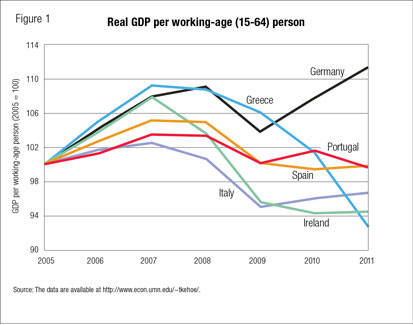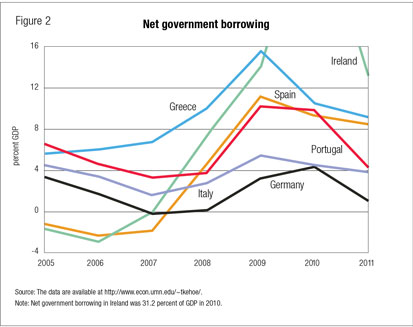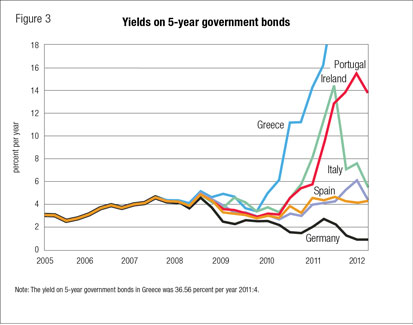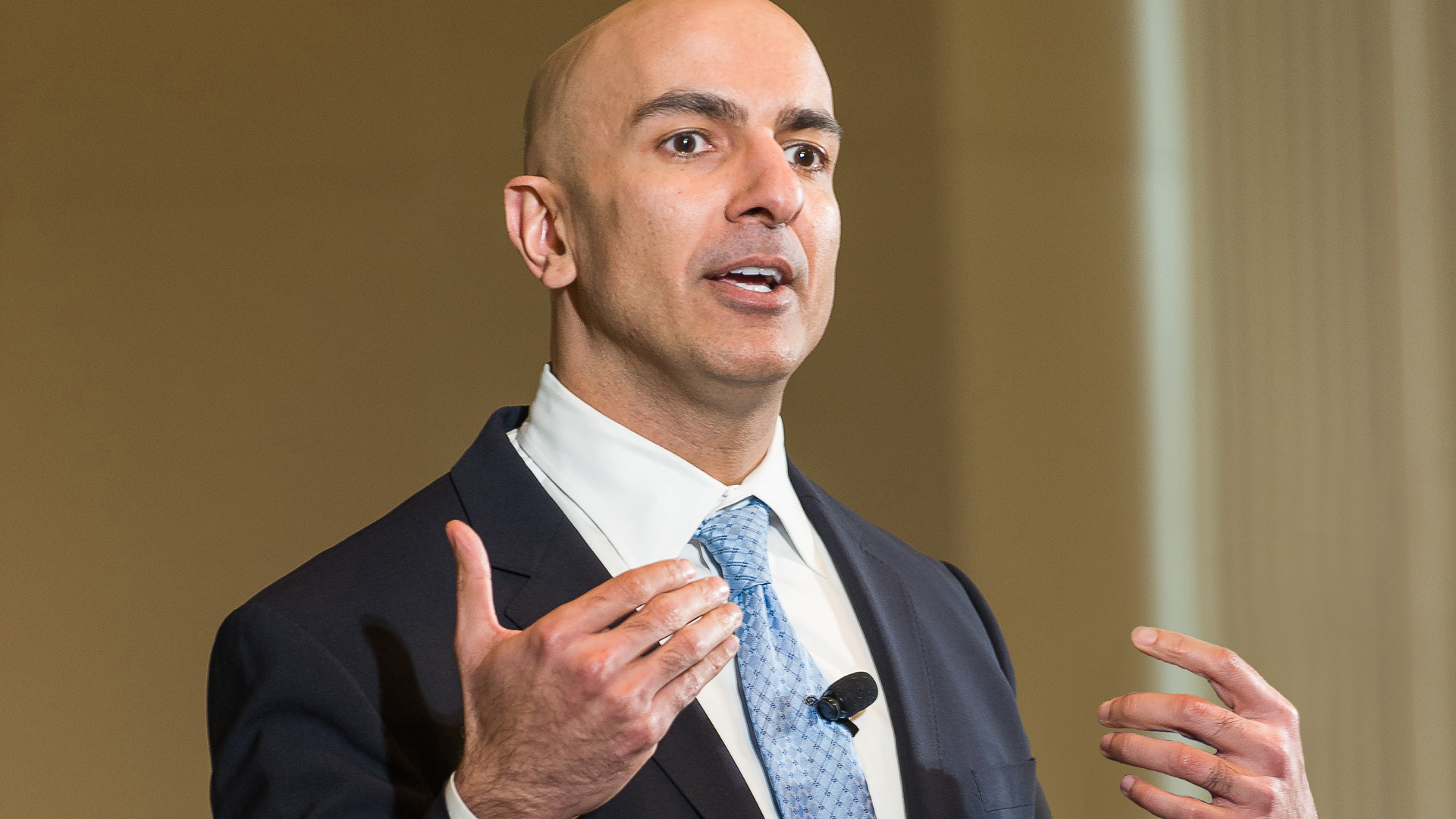Abstract
Two years after the rescue package for Greece provided by the European Union and the International Monetary Fund in May 2010, sovereign debt crises continue to threaten a growing number of countries in the eurozone. We develop a theory for analyzing these crises based on the research of Cole and Kehoe (1996, 2000) and Conesa and Kehoe (2012). In this theory, the need to frequently sell large quantities of bonds leaves a country vulnerable to sovereign debt crisis. This vulnerability provides a strong incentive to the country’s government to run surpluses to pay down its debt to a level where a crisis is not possible.
A deep and prolonged recession, like those currently afflicting many eurozone countries, creates a conflicting incentive, however, to “gamble for redemption”—to bet that the recession will soon end, to sell more bonds in order to smooth government spending, and, if indeed the economy recovers, to reduce debt. Under some circumstances, this policy is the best that a government can do for the citizens of its country, but it carries a risk: If the recession continues too long, the government either will have to stop increasing its debt or will have to default on its bonds.
The theory suggests that policies that result in high interest rates on government bonds and high costs of default provide incentives for a government to reduce its debt and avoid sovereign default. On the other hand, policies that result in low interest rates and low costs of default provide incentives for a government to gamble for redemption. We conclude that policy interventions taken to date by the EU and the IMF—by lowering the cost of borrowing and reducing default penalties—have encouraged eurozone governments to gamble for redemption.
Introduction1
 Beginning in late 2009, the Greek government had difficulties selling its bonds to private investors, who demanded high interest rates. In May 2010, the European Union (EU) and the International Monetary Fund (IMF) approved a 110 billion euro loan package to the Greek government in return for promises of spending cuts to sharply reduce the Greek public deficit. The plan, negotiated by German Chancellor Angela Merkel and Greek Prime Minister George Papandreou, was intended to cover the borrowing needs of the Greek government through 2013. In spite of this rescue package and another, 130 billion euro, package put together between July 2011 and March 2012, the debt crisis in Greece continues into 2012.
Beginning in late 2009, the Greek government had difficulties selling its bonds to private investors, who demanded high interest rates. In May 2010, the European Union (EU) and the International Monetary Fund (IMF) approved a 110 billion euro loan package to the Greek government in return for promises of spending cuts to sharply reduce the Greek public deficit. The plan, negotiated by German Chancellor Angela Merkel and Greek Prime Minister George Papandreou, was intended to cover the borrowing needs of the Greek government through 2013. In spite of this rescue package and another, 130 billion euro, package put together between July 2011 and March 2012, the debt crisis in Greece continues into 2012.
Ireland and Portugal have required similar EU-IMF rescue packages. Cyprus, Italy and Spain have had difficulties selling their bonds. Similar difficulties threaten other members of the European Economic and Monetary Union (EMU)—the countries in the EU that use the euro as their currency, also referred to as the eurozone—like Belgium and France.
In fact, as of April 2012, of the 17 members of the eurozone, only four—Finland, Germany, Luxembourg and the Netherlands—have long-term government bonds with the highest Standard & Poor’s rating, AAA, while the bonds of five countries—Cyprus, Ireland, Italy, Portugal and Spain—have junk ratings, BBB+ or lower. Greek bonds were given the lowest possible rating, CCC, in July 2011, and are currently not rated, but are listed as SD, meaning that the Greek government has selectively defaulted on some issues.
The countries that have suffered debt crises, or are threatened by such crises, got into trouble in different ways. The two crucial common characteristics are that each of these countries is currently experiencing a deep and prolonged recession and each needs to frequently sell large quantities of bonds, either to finance large fiscal deficits or to roll over—and make interest payments on—a large public debt.
We sketch out a theory for analyzing the European sovereign debt crises based on the research of Harold Cole and Timothy Kehoe (1996, 2000) and Juan Carlos Conesa and Kehoe (2012). In this theory, the need to frequently sell large quantities of bonds leaves a country vulnerable to a financial crisis. This vulnerability gives the government the incentive to pay down its debt to a level where such a crisis is not possible. In the event of a deep and prolonged recession, however, the government has a conflicting incentive to “gamble for redemption”—to borrow to smooth government spending, to reduce the debt if the economy recovers and, possibly, to default if the recession continues for too long.
Using this theory, we analyze the various rescue packages and policy interventions made by the EU and the IMF. Policies that result in high interest rates on government bonds and high costs of default provide incentives for a government to reduce its debt. Policies that result in low interest rates and low costs of default provide incentives for a government to gamble for redemption. We conclude that, up until now, policy interventions by the EU and the IMF have encouraged eurozone governments to gamble for redemption. In the theory we present, a government that gambles for redemption is following a policy that is optimal for the citizens of its country. The policy goals of the EU and the IMF may be different from those of the government of an individual country, however, and, to the extent that the EU and the IMF want the government to reduce its debt to avoid a crisis to preserve the stability of the EU, they should adopt policies to discourage the government from gambling for redemption.
Timeline and some data
The Treaty on European Union—signed in Maastricht, Netherlands, on Feb. 7, 1992, and commonly referred to as the Maastricht Treaty—converted the European Community, which then had 12 members, into the European Union. The treaty established four “convergence criteria” as prerequisites for membership in the EMU. One criterion required a country to have an annual public deficit no greater than 3 percent of GDP and a public debt no greater than 60 percent of GDP. Another criterion required the country to participate in the European Exchange Rate Mechanism (ERM)—set up as a voluntary program in 1979—to maintain its exchange rate in a very narrow band around the European Currency Unit (ECU), which eventually became the euro. The other two criteria imposed restrictions on inflation rates and interest rates.
In the process of ratifying the Maastricht Treaty, Denmark and the United Kingdom obtained opt-out clauses from joining the monetary union. All 15 countries that have joined the EU since 1992 were required to join the monetary union. The ERM suffered a major crisis 1992, with a number of countries forced to drop out, and—when the crisis threatened more countries in 1993—the exchange rates bands were widened considerably. The mechanism was restarted in 1999 and is now referred to as ERM II.
Sweden, which joined the EU in 1995, has managed to exploit a legal loophole to avoid adopting the euro: Its accession treaty required Sweden to join the monetary union after meeting the convergence criteria and participating in the ERM II for two years, but it did not explicitly require Sweden to join the ERM II, and it has not done so. The other seven countries in the EU that are not yet in the eurozone are required to go through the process of participating in ERM II and eventually joining the eurozone.
The accompanying table provides a timeline for the major events related to the sovereign debt crises that are ongoing in the eurozone.
Timeline of Events Associated with Eurozone Debt Crises, 2010–2012
|
February 1992 |
Maastricht Treaty signed by 12 members of the European Community: Establishes European Union (EU), commits members to “irrevocable” monetary union. Convergence criteria include rules for public deficit < 3% GDP, debt < 60% GDP. |
|
September 1992 |
ERM (European Exchange Rate Mechanism) crisis forces devaluations of Italian, UK currencies, later, Irish, Spanish currencies. When crisis threatens more counties in 1993, ERM is weakened by considerably widening bands in which exchange rates fluctuate. |
|
June 1997 |
Stability and Growth Pact (SGP), proposed by Germany, imposes financial penalties on countries that violate 3% deficit rule. |
|
January 1999 |
Euro becomes currency in Austria, Belgium, Finland, France, Germany, Ireland, Italy, Luxembourg, Netherlands, Portugal, Spain. ERM II replaces ERM. |
|
January 2001 |
Greece enters eurozone. |
|
November 2003 |
Germany, France announce that they have violated SGP deficit rule. |
|
March 2005 |
EU finance ministers relax SGP deficit rule. |
|
January 2007 –January 2009 |
Slovenia, Cyprus, Malta, Slovakia enter eurozone. |
|
October 2009 |
New Greek government of PM George Papandreou announces deficits have been much higher than reported. |
|
January 2010 |
EU report condemns “severe irregularities” in Greek government’s accounting, announces public deficit in 2009 was 12.7% GDP. |
|
April 2010 |
EU revises Greece’s 2009 public deficit up to 13.6% GDP, Ireland’s 2009 public deficit up to 14.3% GDP. |
|
May 2010 |
EU and International Monetary Fund (IMF) provide €110 bn. rescue package for Greece. |
|
May 2010 |
EU establishes European Financial Stability Facility (EFSF) with initial capital guarantees of €440 bn. European Central Bank (ECB) launches Securities Market Program (SMP) to buy Greek, Irish, Portuguese bonds over the next nine months. |
|
November 2010 |
EU and IMF provide €85 bn. rescue package for Ireland. |
|
January 2011 |
Estonia enters eurozone. |
|
May 2011 |
EU and IMF provide €78 bn. rescue package for Portugal. |
|
July 2011 |
EU Summit starts to plan second rescue package for Greece, plans to force EU banks to accept “voluntary” 50% haircut on Greek bonds. |
|
August 2011 |
ECB resumes SMP, buying Irish, Italian, Portuguese, Spanish bonds. |
|
November 2011 |
Greek PM George Papandreou resigns, replaced by Lucas Papademos. Italian PM Silvio Berlusconi resigns, replaced by Mario Monti. Papademos and Monti are “technocrats”—not politicians. |
|
December 2011 |
ECB cuts repo rate (interest rate on repurchase agreements—loans to banks collateralized by bonds) to 1% per year and eases collateral rules. |
|
December 2011 |
EU leaders negotiate treaty that includes new rules to control deficits, signed by all EU members except the UK, Czech Republic in March. Treaty requires ratification by at least 12 countries by 2013. Only countries that ratify treaty will be eligible for rescue packages. |
|
March 2012 |
EU and IMF finalize second Greek rescue package of €130 bn. Enough bond holders agree to 53.5% face-value haircut with restructuring that lengthens maturities and reduces interest payments (for a total haircut of 75%) to allow the Greek government to invoke CACs (collective action clauses) that force settlements on all bond holders. These CACs are controversial because they were introduced retroactively by Greek government. |
European leaders had seen the need to coordinate fiscal policy in a monetary union. In 1997, at the insistence of Germany, they adopted the Stability and Growth Pact (SGP), which imposed financial penalties on countries that violated the convergence criterion that the public deficit not exceed 3 percent of GDP. Nonetheless, when the French and German governments announced that they had violated this deficit limit in 2003, they were not penalized, reducing the credibility of the SGP.
The details differ on how various countries became vulnerable to sovereign debt crises: The Greek government borrowed heavily during Greece’s rapid growth early in the 2000s and employed fraudulent accounting practices to mask its large violations of the 3-percent-deficit rule. The Irish government was in very good fiscal shape until it guaranteed the debts of the six major private banks based in Ireland in 2008. When the housing market collapsed in late 2008 and 2009, leading to the collapse of these banks, the Irish public deficit and debt soared. Portugal took advantage of the low interest rates at which it could borrow after joining the eurozone to build up a large public debt. When Spain was hit by recession in 2008, the government reacted with massive Keynesian stimulus policies, running large public deficits. Although the Spanish public debt started from a very low level, it increased rapidly because of these deficits.
The problems faced by the Italian government stem from conditions very different from those in Spain. Although Italy had low public deficits, it had started with a very high level of debt. Indeed, Belgium and Italy had entered the EMU with public deficits that substantially exceeded the 60-percent-debt rule only because they were deemed to be on a “satisfactory pace” to reducing the public debt to 60 percent of GDP. Yet, in the case of Italy, much of this satisfactory pace was illusory, the product of creative accounting of exactly what constituted government expenditures and government revenues. France employed similar sorts of creative accounting.2
In spite of these differences in initial conditions, Greece, Ireland, Italy, Portugal and Spain (GIIPS) share two crucial characteristics: First, as the data in Figure 1 show, the recoveries from the 2008–2009 recessions in these countries have been nonexistent. Notice that, in Figure 1, the German economy has started to recover in 2010 and 2011, if only weakly, while the GIIPS are still mired in recession. Second, as the data in Figure 2 show, the GIIPS have large borrowing requirements because of high deficits or large debts or both.
Self-fulfilling debt crises
The need to frequently sell large quantities of bonds leaves the countries vulnerable to self-fulfilling debt crises of the sort analyzed by Cole and Kehoe (1996, 2000) and Conesa and Kehoe (2012). In such a crisis, if investors expect a government to have trouble repaying its debt, they pay a low price at auctions of new government bonds. The resulting low value of the new bond sales makes it difficult for the government to repay the old bonds becoming due, thus justifying the expectation of a crisis. If, however, investors do not expect the government to have trouble repaying its debt, they are willing to pay a high price for new bonds. This expectation too is self-fulfilling.
To understand the reasoning in the model, we start by examining two crucial relations: the government budget constraint—which relates sales of new bonds and payments on old bonds to government expenditures and tax receipts—and the relation between the price that investors pay for bonds and the probability of a sovereign default. We then explain how the government determines its optimal policy and how financial crises can occur.
Government budget constraint
In every time period—which can be a year or longer or shorter, depending on the application—the government’s budget constraint requires that the total of resources collected in the form of tax revenues and receipts from new bond sales be equal to the total of resources spent in the form of government expenditures and transfer payments and coupon payments on outstanding bonds and payments of face value on bonds reaching maturity. To keep things simple, we lump transfer payments into expenditures and coupon payments on outstanding bonds into payments of face value on bonds reaching maturity. We can write the government’s budget constraint as
tax revenues + receipts from new bond sales
= expenditures + payments on bonds becoming due.
Notice that this constraint does not require the government to balance its budget in the traditional sense because it does not require tax revenues to equal expenditures. The difference between expenditures and tax revenues is referred to as the government’s primary deficit. We can rewrite the government’s budget constraint as
primary deficit = expenditures − tax revenues
= receipts from new bond sales − payments on bonds becoming due.
To analyze the evolution of the sovereign debt crises in the eurozone, however, it is more useful to write the government’s budget constraint in a different way as
net borrowing = face value of new bond sales − payments on bonds becoming due
= primary deficit + face value of new bond sales − receipts from new bond sales.
The payments on bonds becoming due are equal to their face value unless the government defaults. Consequently, unless the government defaults, the face value of new bond sales minus the payments on bonds becoming due is equal to the net government borrowing depicted in Figure 2. Because investors discount the future, they pay a price for the bond less than the face value of the bond when it matures. If investors pay a very low price for new bonds, then receipts from new bond sales fall far short of the face value of the bonds, and net borrowing is substantially greater than the primary deficit. We focus on net borrowing because it measures the increase in government debt.
Pricing bonds
Consider an investor whose holdings of the sovereign bonds of a particular country constitute a small fraction of his or her total portfolio. At a bond auction, we assume that this investor is willing to bid a price equal to the expected present discounted value of the return on the bond.3
First consider the case where the investor is sure that the government will not default. Suppose that the government promises to pay back one euro in one year and that the consumer discounts future returns at 2 percent per year. Then the price of the bond is the present discounted value of one euro next year, which is a little more than 98 euro cents,
1/1.02 = 0.98039.
This number is also referred to as the discount factor. The investor multiplies any promised return in one year by the discount factor to obtain its present discounted value. For example, the investor is willing to pay 980.39 euros for a bond paying 1000 euros next year. Another way to think about this is that, if 980.39 euros are invested at 2 percent, then after one year they are worth 1000 euros. For a bond with a longer maturity, the investor multiplies the discount factor by itself N times, where N is the number of years of maturity. For a bond paying 1000 euros in 10 years, for example, the investor would be willing to pay 820.35 euros,
820.35 = (0.98039)10 x 1000.
Now consider the case where there is a positive probability of default. The difference between the return if there is no default and the return if there is default is referred to as the haircut. Suppose that the probability of a default is 50 percent and that the haircut is 50 percent, which implies that the payoff if there is default is 50 percent. Then the expected return on the bond with a face value of 1000 euros is 750 euros,
expected return = probability of no default × payment if no default+ probability of default × payment if default
750 = 0.5 x 1000 + 0.5 x 500.
The price of the bond is the expected present discounted value of the return, which in this case is 735.29 euros,
price = discount factor × expected return735.29 = 0.98039 x 750.
The yield—which is the implicit interest rate on the bond—is 36 percent,
0.36 = (1 / 0.73529) - 1
because, if 735.29 euros are invested at 36 percent, after one year they are worth 1000 euros. The spread—the difference between the yield and that on a safe bond—is 34 percentage points.
Our example illustrates how an increase in the probability that investors assign to a default results in an increase in the yield on the bond. Figure 3 depicts the yields on government bonds in the GIIPS compared with those in Germany. Notice how spreads on GIIPS bonds increased starting in 2008.
An attractive feature of our numerical example is that it provides a rationalization for the yields in Figure 3. In the fourth quarter of 2011, for example, German bonds, which can be thought of as a safe investment, had a yield of about 2 percent, while Greek bonds had a yield of about 36 percent, which is the yield if the probability of default is 50 percent and the expected haircut is 50 percent. Of course, there are other combinations of probabilities of default and haircuts that result in this same 36 percent yield.
Optimal government policy and crises
In every time period in the model, the government must decide how much new debt to sell and whether or not to default. We assume that the government is benevolent, in that it values the welfare of consumers, that is, the citizens of the country, who value both private consumption and government expenditures. We also assume that consumers—and consequently the government—value smooth paths of private consumption and government expenditures. Sharp cuts in government expenditures are particularly painful. Defaults are also costly in that they disrupt financial markets, which causes a drop in the GDP of, say, 5 percent—which we refer to as the default penalty—that is available for government expenditures, private consumption and repayment of debt. These assumptions are intuitively appealing and fairly innocuous.
We make a number of other assumptions that are more restrictive to keep the analysis simple. We assume, for example, that tax revenues are a constant fraction of GDP because tax rates are fixed. We also assume that the default penalty is permanent and that, if the government defaults, it is permanently excluded from borrowing. Cole and Kehoe (1996, 2000) model consumers within a country as making private investment decisions, but here—again to keep things simple—we follow Conesa and Kehoe (2012) in having consumers consume all after-tax GDP rather than investing some of it. These assumptions can be relaxed without changing the qualitative results of the model. How much quantitative results change depends on the parameterization, of course, and this is a topic that deserves future research.
A financial crisis is self-fulfilling if the expectation that the government will default causes it to default in a situation where it would otherwise pay for the bonds becoming due. For low levels of debt, self-fulfilling crises are not possible. For higher levels of debt—those above a threshold that we call the upper safe debt limit—self-fulfilling crises are possible. For even higher levels of debt—those above a threshold that we call the upper sustainable debt limit—the government prefers to default rather than pay for the bonds becoming due.
The timing within a period is such that investors decide what price to bid in the auction for new government bonds before the government decides whether or not to default on the old bonds becoming due. Suppose that, before the auction, investors receive some sort of bad news that makes them expect the government to default this period. Under what conditions will this expectation be self-fulfilling? The investors expect that the government will be in default the subsequent period because it is excluded from financial markets. The price that the investors offer for new bonds is the present discounted expected payment in the case of default, which is low or zero. The government can either default or pay for the bonds becoming due. For levels of debt equal to or below the upper safe debt limit, the government prefers to pay for the bonds becoming due and suffer the drop in government expenditures but avoid paying the cost of defaulting. For these low levels of debt, investors will pay a high price, equal to the present discounted face value for new bonds, no matter what the news is. If, however, debt is above the upper safe debt limit, a self-fulfilling crisis occurs if there is bad news. For high levels of debt, those above the upper sustainable debt limit, the government chooses to default even if investors buy the new bonds offered.
The probability that investors assign to receiving bad news in a period is arbitrary.4 At the beginning of a period, the bad news arrives or it does not. Notice that, in the bond auction in a period, if bad news had not arrived early in the period, then the bond price depends on the probability of receiving bad news in the next period.
Cole and Kehoe (1996, 2000) call the interval of debt levels above the upper safe limit but equal to or below the upper sustainable limit the crisis zone. If debt is in this zone, a self-fulfilling crisis can randomly occur. Since interest rates are high when the debt being sold is in the crisis zone and the probability of a costly default is positive, a government will optimally choose to run surpluses to run its debt down to the upper safe limit. Once debt reaches the upper safe limit, interest rates drop and the probability of default disappears. Since sharp cuts to government expenditures are painful, however, the government may choose to pay down the debt over a number of periods.
In a quantitative model calibrated to match features of European data, Conesa and Kehoe (2012) show that the upper safe limit is about 120 percent of GDP while the upper sustainable limit is about 210 percent of GDP. These numbers make sense in terms of the numbers currently used by policymakers in Europe, in particular, the need to reduce Greek debt below 120 percent of GDP to eliminate the possibilities of future crisis.5
Gambling for redemption
As we have just argued, financial crises and defaults on sovereign debt are costly for a country, and the government of a country that finds itself vulnerable to a self-fulfilling crisis has the incentive to pay down its public debt so that it does not need to frequently sell large quantities of bonds. As Conesa and Kehoe (2012) point out, however, countries that are in deep recessions have an opposite incentive: to cut government spending very slowly and increase the public debt, gambling that a recovery in the economy will lead to a recovery in tax revenues, at which point it can stop increasing the debt. If the country is unlucky and the recession is prolonged, however, the country can find itself more vulnerable to a self-fulfilling debt crisis and ultimately may be forced to default.Conesa and Kehoe (2012) modify the Cole-Kehoe model so that the country finds itself in an unexpected recession, where GDP is, say, 10 percent lower than its otherwise constant level.6 This is meant to correspond to the situation in Europe in 2008. In every period there is a constant probability—say 0.2, that is, one in five—that the economy will recover. With this stochastic process, which is like flipping a biased coin with the probability of heads being the probability of recovery, the expected waiting time for a recovery is a number of periods equal to the reciprocal of the probability of recovery. If, for example, the probability of an economic recovery is 0.2 per year, then, at any time where a recovery has still not occurred, the expected waiting time for a recovery is 1 / 0.2 = 5 years.
To understand gambling for redemption, consider first the case where self-fulfilling debt crises are not possible because, for some reason, the probability of bad news is zero. Then, because it wants to smooth expenditures as much as possible, a government would optimally choose to borrow when it is in recession at a high bond price equal to the present discounted face value, planning to pay back when the economy recovers. Like a gambler at a roulette wheel who keeps doubling his bet, the government is gambling that the recession will not continue for too long. Unlike the gambler, the government is doing something beneficial while it is gambling. It is smoothing government expenditures, something that the citizens of its country value.
If the recession does go on, there are two possibilities for the equilibrium outcome, depending on the costs of default: If the costs of default are high, the government will borrow less and less each period until its debt converges to an upper limit above which investors know that the government would default. If the costs of default are lower, the government will optimally choose to default after a finite number of periods, borrowing in the period before default at a price equal to the present discounted expected value of the face value if there is a recovery in the next period and the payoff in default if there is no recovery. This is not a self-fulfilling crisis: Investors and the government correctly anticipate default if there is no recovery. The only uncertainty is whether the economy will recover or not.
Consider now the general case where self-fulfilling crises are possible but where the economy is also in a recession from which it might recover. The government faces conflicting incentives. Various outcomes are possible and reasonable, depending on the values of parameters. The government could optimally choose either to pay down its debt to the upper safe limit or to borrow still more, running up its debt, gambling for redemption. The optimal choice depends on the costs of default, the probability of a crisis and the probability of recovery from recession.
Cristina Arellano (2008) argues that defaults can also occur when GDP is low enough. In her model, countries borrow large amounts in booms because interest rates are low because debt is below the upper safe limit. When a recession hits, however, the same amount of debt may be above the new upper safe limit, and interest rates rise, making it costly to roll over the debt. For a sufficiently large drop in GDP, a level of debt that is safe if GDP is high can be above the upper sustainable limit if GDP is low, in which case the government now prefers to default.
Analyzing EU and IMF policy and extending the model
We can use our theory to evaluate the impact of policies followed by the EU and the IMF. Any policy that decreases the price that a country receives for its bonds (that is, increases the yields that it pays), or increases the costs of default, provides the government with incentives to reduce its debt to exit the crisis zone. In contrast, any policy that increases bond prices (lowers the yields), or lowers the costs of default, provides the government with incentives to gamble for redemption.
The rescue packages listed in the timeline stopped self-fulfilling crises in Greece, Ireland and Portugal. They also provided credit to countries at lower interest rates than the yields presented in Figure 3. These policies can be interpreted as encouraging gambling for redemption. It is worth pointing out, however, that the rescue packages also explicitly required austerity measures, even if these requirements were later violated, especially in the case of Greece.
One policy that very clearly encourages gambling for redemption is the European Central Bank’s Securities Market Program (SMP). The SMP buys bonds of countries whose bond prices fall too low. By propping up their bond prices and keeping yields low, the SMP reduces incentives to pay down the debt and escape the crisis zone. Similarly, the ECB’s policy of reducing its repo rate and relaxing collateral constraints to encourage banks to buy government bonds with high yields drives up the price of bonds and encourages gambling for redemption.
Another policy that may have encouraged gambling for redemption was the 50 percent haircut on Greek bonds planned at the European Summit in July 2011 to be imposed on private investors, principally private banks in the EU. By labeling the haircut voluntary, the EU intended to eliminate some costs of default, such as triggering credit default swaps (CDSs), securities that pay the buyer in the event of a default. EU leaders thought that triggering CDSs would be very disruptive to the financial system, both inside and outside Greece. Greece had already reached a debt level that it could not hope to repay, but planning “voluntary” haircuts on Greek bonds signaled other troubled governments that such a reduction in the costs of default might be available for them.
By March 2012, it was clear, however, that this sort of “voluntary” haircut was not feasible, mostly because courts would not rule out claims on CDSs. Greece ended up imposing a much larger haircut, negotiating with the majority of bond holders and enforcing the settlement on the rest of bond holders by appealing to CACs (collective action clauses). There are currently doubts about the legality of this move, however, because the CACs were inserted into the bond contracts retroactively. A challenge for Europe is how to best design restructuring procedures for countries that might follow Greece into default while minimizing adverse incentives for other countries.7
While our theory provides an appealing explanation of why the threat of sovereign debt crises in Europe has been going on for so long, it leaves open a couple of major questions. We can use our theory to understand the behavior of leaders of countries threatened by debt crisis, like George Papandreou in Greece, but it does not help us understand the behavior of EU leaders like Angela Merkel of Germany and Nicolas Sarkozy of France, who have struggled to provide rescue packages. It may that they too have been gambling for the redemption of the eurozone itself, rather than their national economies. Merkel and Sarkozy may have believed that the only thing that will pull the eurozone out of the danger of debt crises is a vigorous economic recovery from the recession, and they are just trying to hold the EMU together until that happens. It would be useful to develop a model of this.8
It is also clear that the institutional design of the EMU—in particular, the mechanisms to enforce fiscal discipline, like the Stability and Growth Pact—is inadequate. European leaders are currently struggling to come up with a better institutional design, and it would be worth developing a theory of the optimal design of the EMU.
A related question is why sovereign debt crises like those in Europe do not currently threaten countries like Japan, the United Kingdom and the United States. These countries, like those in the eurozone, have large public debts and have suffered from the recent recession. Thomas Sargent (2012) presents a provocative narrative arguing that a key difference in the United States is that the central government has the power to raise substantial resources through taxation, a power the EU lacks. Another crucial difference is that each of these countries, unlike the eurozone countries, has its own currency whose value can fluctuate freely in response to changing economic conditions. This too is worthy of further research.
Endnotes
1 We thank Tito Cordella, Isabel Correia, Patrick Kehoe, Narayana Kocherlakota, David Levine, Thomas Lubik, Fabrizio Perri, and Pedro Teles for helpful discussions. We also thank Jose Asturias, Wyatt Brooks, and Laura Sunder-Plasssmann for excellent research assistance. The data presented in the figures are available here. The views expressed herein are those of the authors and not necessarily those of the Federal Reserve Bank of Minneapolis or the Federal Reserve System.
2 See Paul De Grauwe (2009) for a discussion of the politics of violations of the Maastricht Accords.
3 We assume that the bond holdings are a small fraction of the portfolio because this implies that the investor behaves as if he or she were risk-neutral, justifying expected-present-discounted-value pricing. If the bond holdings are a large fraction of the portfolio and the investor is risk-averse, then he or she would pay less, to compensate for the riskiness of the bond. We ignore any liquidity services provided by bonds and alternative assets, which can complicate the pricing relation in minor ways.
4 Cole and Kehoe (1996, 2000) model this news shock as what economic theorists call a sunspot, a random variable that affects the equilibrium only through investors’ expectations. The value of bad news is arbitrary and can vary over time, which would account for fluctuations in the spreads in Figure 3. The arbitrary nature of exactly what constitutes bad news is how the model captures what finance ministers refer to when they complain about their country’s bonds being at the mercy of the financial markets.
5 Whether this gives us more confidence in the quantitative properties of the model or more confidence in European policymakers is an open question.
6 To keep things simple, we assume that GDP does not have a growth trend. If GDP is 100 before the recession, it falls to 90 during the recession. A recovery is a return to 100. If there is a default during the recession, GDP falls another 5 percent, to 85.5. A recovery now only increases GDP to 95. It is easy to convert the model to one in which the economy is growing at a constant rate and in which neither the qualitative results nor the quantitative results change. In a more complicated model, the shock could affect the growth trend. Mark Aguiar and Gita Gopinath (2006) argue that shocks to growth rates have stronger effects on default incentives than do changes in levels.
7 David Benjamin and Mark Wright (2009) and Pablo D’Erasmo (2011) provide a theory for renegotiation between a government and a representative of the bond holders. They argue that it is worth delaying restructuring until countries have low default risk and high output because those are times when mutually beneficial outcomes can be obtained more easily. Their results imply that renegotiation is particularly difficult now when many Eurozone countries are still deep in recession and where there is substantial uncertainty about the future.
8 Arellano and Yan Bai (2012) argue that a reason for a lender—and the EU itself has become a major lender to troubled countries though the European Financial Stability Facility (EFSF) and the ECB’s SMP and repurchase agreements—to be lenient with a subset of borrowers in default is to avoid other defaults from other borrowers.References
Mark Aguiar and Gita Gopinath (2006), “Defaultable Debt, Interest Rates and the Current Account,” Journal of International Economics, 69, 64–83.
Cristina Arellano (2008), “Default Risk and Income Fluctuations in Emerging Economies,” American Economic Review, 98, 690–712.
Cristina Arellano and Yan Bai (2012), “Linkages across Sovereign Debt Markets,” Federal Reserve Bank of Minneapolis.
David Benjamin and Mark Wright (2009), “Recovery before Redemption: A Theory of Delays in Sovereign Debt Renegotiations,” Centre for Applied Macroeconomic Analysis, Working Paper 2009-15, Australian National University.
Harold L. Cole and Timothy J. Kehoe (1996), “A Self-Fulfilling Model of Mexico's 1994–95 Debt Crisis,” Journal of International Economics, 41, 309–330.
Harold L. Cole and Timothy J. Kehoe (2000), “Self-Fulfilling Debt Crises,” Review of Economic Studies, 67, 91–116.
Juan Carlos Conesa and Timothy J. Kehoe (2012), “Gambling for Redemption and Self-Fulfilling Debt Crises,” Federal Reserve Bank of Minneapolis Staff Report 465.
Pablo D’Erasmo (2011), “Government Reputation and Debt Repayment,” Working Paper, University of Maryland.
Paul De Grauwe (2009), “The Politics of the Maastricht Convergence Criteria,” VoxEU, 15 April 2009.
Thomas J. Sargent (2012), “United States then, Europe now,” Nobel Prize Lecture, New York University.








